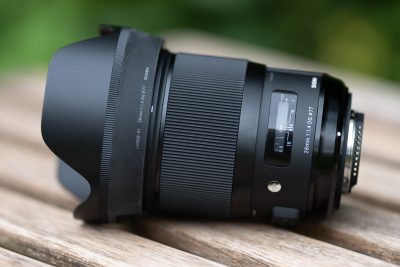Sigma 28mm f1.4 Art review
-
-
Written by Thomas
Quality
Testing: Longitudinal Chromatic Aberration and focus shift
Lenses with focal ratios of f2.8 or larger are often prone to longitudinal color aberrations (loCA, a.k.a. “axial color” or “Bokeh CA”). These normally show up as magenta coloration in the foreground and greenish hues in the background and are not easily corrected in post-processing. But the Sigma 28mm f1.4 Art is very good in this respect: it shows very little loCA even wide open. The following 100% crops show the foreground on the left and the background on the right with the first crop at f1.4, second at f2.0, third at f2.8:
Longitudinal Chromatic Aberration (loCA)
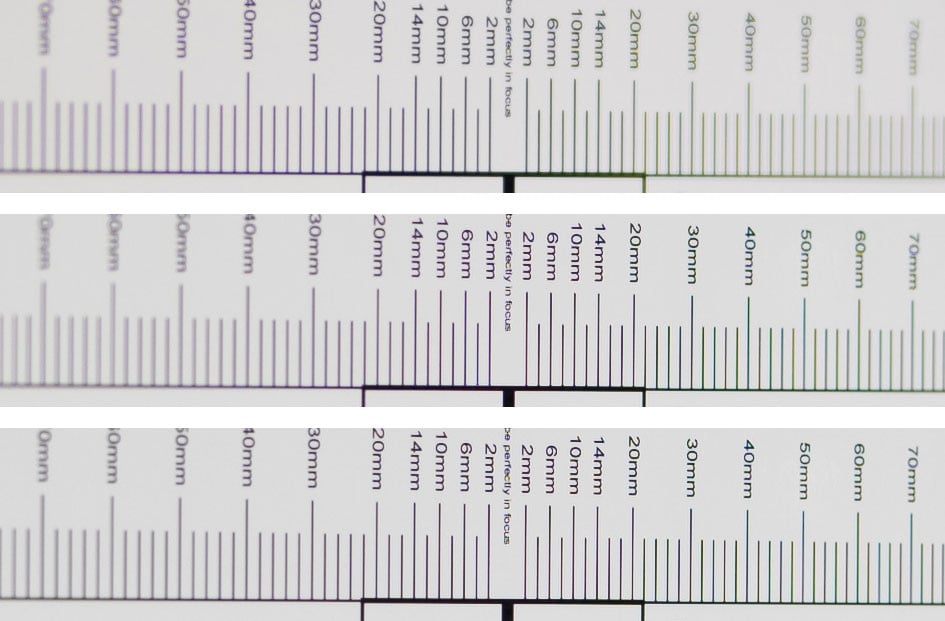
Above: Sigma 28mm f1.4 Art at f1.4, f2.0, f2.8; 100% crops
As you can see in the following real life shot there is only a little magenta haloing around high-contrast edges (left) and a weak green outline around background subjects:

Above: Sigma 28mm f1.4 Art at f1.4; 100% crop; click image to access 4k version
But the test also revealed that focus shifts visibly away from the camera when stopping down: see how the text on the left side e.g. at “40mm” clearly becomes less sharp when the lens is stopped down from f1.4 to f2.0. Fortunately the plane of sharpest focus still becomes sharper at f2.0. And when focusing using the actual aperture like when shooting video or using the lens on a modern mirrorless body this should not be a problem.
The Zeiss Otus 28mm f1.4 also has very little loCA (see here) while the Nikon 28mm f1.4E (here) shows the effect more strongly wide open.
Sharpness and contrast
Let’s have a look at the theoretical performance of the Sigma 28mm f1.4 Art first and compare it to the alternatives from Zeiss and Nikon:
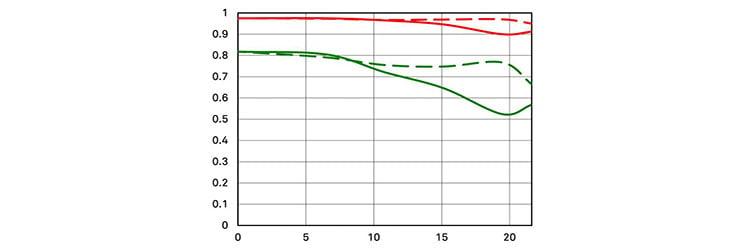
Above: MTF Sigma 28mm f1.4 Art
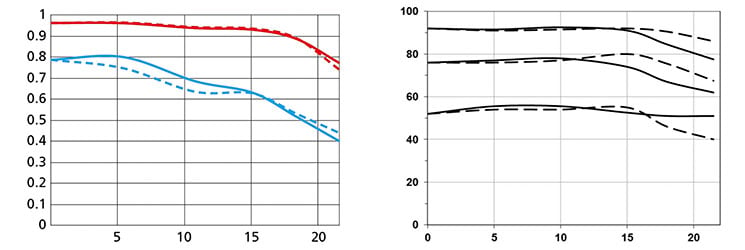
Above: MTF Nikon 28mm f1.4E (left), Zeiss Otus 28mm f1.4 (right)
The computed MTF charts from Sigma and Nikon show contrast at 10 line-pairs per mm and 30 lp/mm at f1.4 without influence of diffraction. Higher values are better (more contrast) and the closer the line-pairs are together the less astigmatism (= resolution depends on the orientation of the test-pattern) the lens has. The MTF chart of the Zeiss (designed) lenses shows the measured contrast wide open at 10, 20 and 40 lp/mm. This includes the influence of diffraction so is not entirely comparable. The x-axis displays the distance from the optical axis (=center of the sensor) in mm.
From the charts the Sigma 28mm f1.4 Art looks a little better than the Nikon. But both lenses show a drop in resolution already towards the APS-C-corner and further towards the FX-corner while the Zeiss produces a very even resolution across the frame. The Sigma also shows quite some astigmatism towards the FF-corner. But let’s see how this theoretical performance of the Sigma translates into real life results in the sharpness test based on Siemens-stars at 4 mm (center), 13 mm (APS-C-corner), and 20 mm (FF-corner) off axis. Processing was done in Lightroom 8/CRAW 11 from RAW to Adobe Color profile. Noise-reduction is set to 0, sharpening to 50/0.5/36/10, with no extra tone, color, or saturation adjustment. White-balance was adjusted to a neutral white and I did some exposure compensation to make the brightness of all crops match. So you will not see light fall-off in the corners.
The following 100% crops show the Sigma 28mm f1.4 Art shot on a 46MP Nikon Z7 (with FTZ-adapter) from f1.4 down to f11.
Sigma 28mm f1.4 Art; 100% crop from center, APS-C/DX-corner, FF/FX-corner

Above: Sigma 28mm f1.4 Art at f1.4

Above: Sigma 28mm f1.4 Art at f2.0

Above: Sigma 28mm f1.4 Art at f2.8

Above: Sigma 28mm f1.4 Art at f4.0

Above: Sigma 28mm f1.4 Art at f5.6

Above: Sigma 28mm f1.4 Art at f8.0

Above: Sigma 28mm f1.4 Art at f11
These 100% crops directly from a 46MP Nikon Z7 sensor shows a somewhat soft performance even in the center wide open. The center recovers to very sharp when stopped down to f2.8 as does the FF-corner, but the APS-C corner still suffers from astigmatism even at f4.0.
The following comparison shows the Sigma 28mm f1.4 Art, Zeiss Otus 28mm f1.4, and Nikon 28mm f1.4E ED (shot on a 36MP D810) wide open. Linear resolution of the D810 sensor is 12% lower than from the Z7 sensor which favors the Nikon a bit in this comparison but should not make a distinct difference:
Sigma 28mm f1.4 Art; comparison with other lenses at f1.4

Above: Sigma 28mm f1.4 Art at f1.4

Above: Zeiss Otus 28mm f1.4 at f1.4

Above: Nikon 28mm f1.4E ED on a 36MP D810 at f1.4
Within the APS-C/DX image-circle the Zeiss Otus clearly rules the roost. Only in the FF-corner the Sigma is comparable. And the Nikon is obviously sharper in the center than the new Sigma but it also is the softest of the three lenses in the FF-corner.
Performance at long distances
The Siemens-star test-targets are shot at a distance of 45x focal length (i.e. at around 1.8m). But as performance of lenses also depends on the shooting distance I did another series of test-shots of a city around 1 km away. Processing was done in Lightroom 8/CRAW 11 from RAW to Adobe Color profile with the lens-profile automatically applied. Noise-reduction is set to 0, sharpening to 50/0.5/36/10, with no extra tone, color, or saturation adjustment. I used autofocus at the largest aperture and did not change focus for other apertures. All shots of the Sigma 28mm f1.4 Art were made on a 46MP Nikon Z7 (with FTZ-adapter) at ISO 64 and image stabilization switched off.
The main image shows the complete scene wide open to give you an impression of the angle of view and to judge vignetting. You can access the respective full resolution shots up to f11 via the links beneath the main image. Following the main image are 100% crops from the Sigma 28mm f1.4 Art from the center, the APS-C-corner and the FF-corner down to f11.
You can click on each image to access the large original. Please respect our copyright and only use those images for personal use.
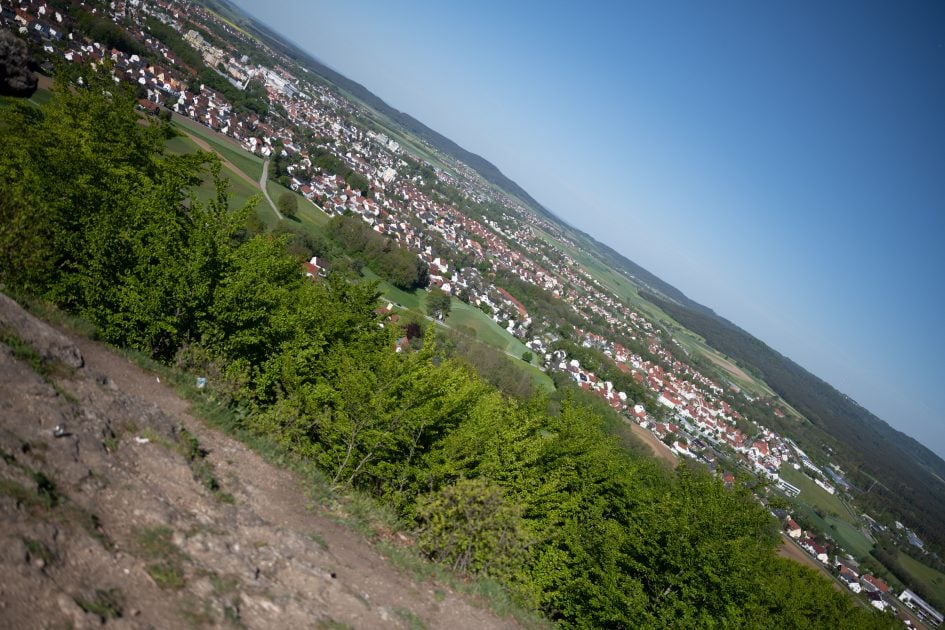
Above: Sigma 28mm f1.4 Art at f1.4; click image for 4k version, also available as large original at f1.4, f1.6, f1.8, f2.0, f2.8, f4.0, f5.6, f8.0, f11

Above: Sigma 28mm f1.4 Art at f1.4; 100% crop from center, APS-C-corner, FF-corner

Above: Sigma 28mm f1.4 Art at f2.0; 100% crop from center, APS-C-corner, FF-corner

Above: Sigma 28mm f1.4 Art at f2.8; 100% crop from center, APS-C-corner, FF-corner

Above: Sigma 28mm f1.4 Art at f4.0; 100% crop from center, APS-C-corner, FF-corner

Above: Sigma 28mm f1.4 Art at f5.6; 100% crop from center, APS-C-corner, FF-corner

Above: Sigma 28mm f1.4 Art at f8.0; 100% crop from center, APS-C-corner, FF-corner

Above: Sigma 28mm f1.4 Art at f11; 100% crop from center, APS-C-corner, FF-corner
Again the Sigma is a bit soft in the APS-C image-circle in this long distance test at f1.4 and needs stopping down to f2.8 to produce really crisp high contrast edges. That being said one has to keep in mind that the performance in the challenging FF-corner is certainly laudable.
I shot the same scene with the Sigma 28mm f1.4 Art, Nikon 28mm f1.4E ED, and Zeiss Otus 28mm f1.4 at different days but similar atmospheric conditions:
Sigma 28mm f1.4 Art; comparison with other lenses at f1.4

Above: Sigma 28mm f1.4 Art at f1.4; 100% crop from center, APS-C-corner, FF-corner

Above: Zeiss Otus 28mm f1.4 at f1.4; 100% crop from center, APS-C-corner, FF-corner; available as large original at f1.4, f1.6, f1.8, f2.0, f2.8, f4.0, f5.6, f8.0, f11

Above: Nikon 28mm f1.4E ED on a D810 at f1.4; 100% crop from center, APS-C-corner, FF-corner; available as large original at f1.4, f1.8, f2.0, f2.8, f4.0, f5.6, f8.0, f11, f16
The long distance comparison evens out the differences from the Siemens star test a bit: The Sigma looks still a bit softer in the center but produces the clearest APS-C-corner and also has a slight lead over the Otus in the FF-corner.
Vignetting
To make it easier to see light fall-off in the corners of a full-frame sensor I’ve arranged a series of shots with the new Sigma Art and the Zeiss Otus at different apertures for comparison. All images were developed to the same brightness in the center. No lens profiles were applied which was a bit tricky, as Adobe uses an “integrated lens profile” for the Sigma which cannot be switched of. So I had to convert the RAW files with Capture NX-D where I could switch off vignette control
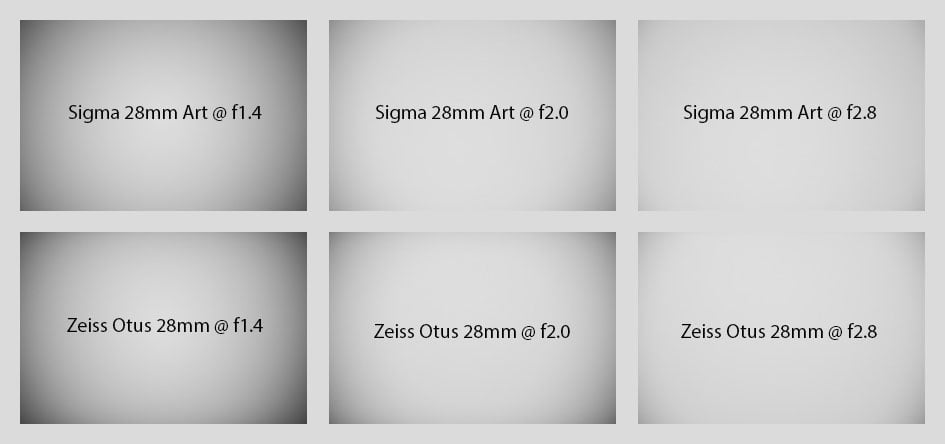
Above: Sigma 28mm f1.4 Art (1st row), Zeiss Otus 28mm f1.4 (2nd row)
The sample images above show that the Sigma has a bit less vignette than the Zeiss Otus.
Rendering of point-light sources at night-shots
Night-shots pose a different challenge for lenses as the contrast is even higher than under bright sun and point-light sources can reveal some weaknesses such as coma, haloing and color-aberrations that do not show up as prominently in other test-shots. The 100% crops below the main image show the effect of coma in the FF-corner of the Sigma 28mm f1.4 Art, Zeiss Otus, Nikon and Zeiss Otus at various apertures:
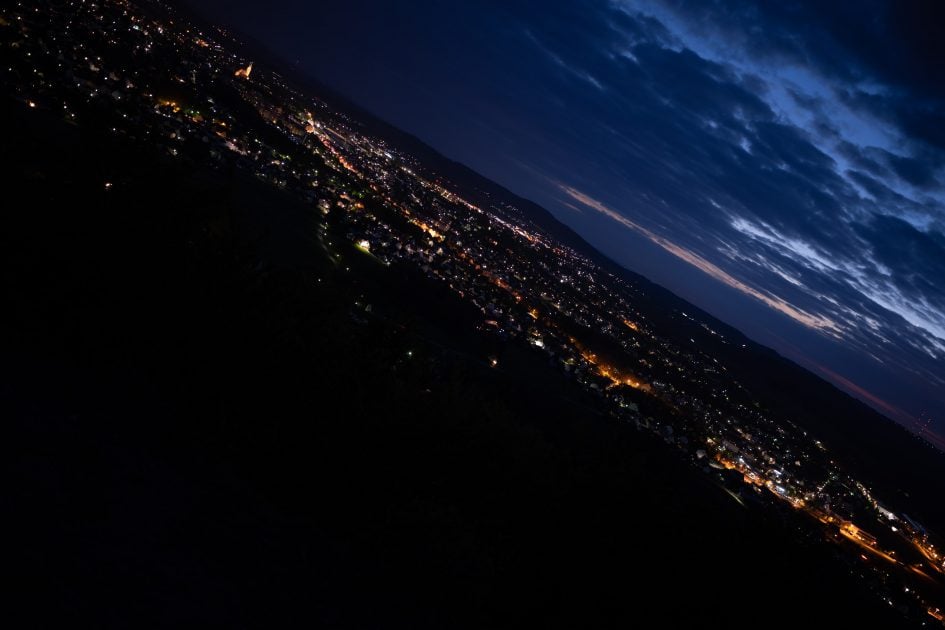
Above: Sigma 28mm f1.4 Art at f1.4; click image for 4k version, also available as large original at f1.4, f2.0, f2.8, f4.0, f5.6, f8.0

Above: Sigma 28mm f1.4 Art; 100% crops from the FF-corner at f1.4 (left), f2.0 (middle), f2.8 (right)

Above: Zeiss Otus 28mm f1.4; 100% crops from the FF-corner at f1.4 (left), f2.0 (middle), f2.8 (right)

Above: Nikon 28mm f1.4E on a 36MP D810; 100% crops from the FF-corner at f1.4 (left), f2.0 (middle), f2.8 (right)
The Sigma 28mm f1.4 Art produces very little coma wide open – very good! Both the Zeiss Otus and the Nikon show some coma albeit not a very strong one.
Rendering of out-of-focus point-light sources
This test is for the rendering of point-light sources in an out-of-focus background. The circle of confusion that is produced by this test is pretty indicative of Bokeh performance (in the background) and light fall-off. Ideally the out-of-focus image of the point-light is evenly lit and perfectly circular, with no “onion-rings”, and without coloration. Large aperture lenses normally produce an effect known as “cat’s eye” the further away from the optical axis the point-light is projected. This is due to optical vignetting in the lens barrel when light enters the lens from an angle.
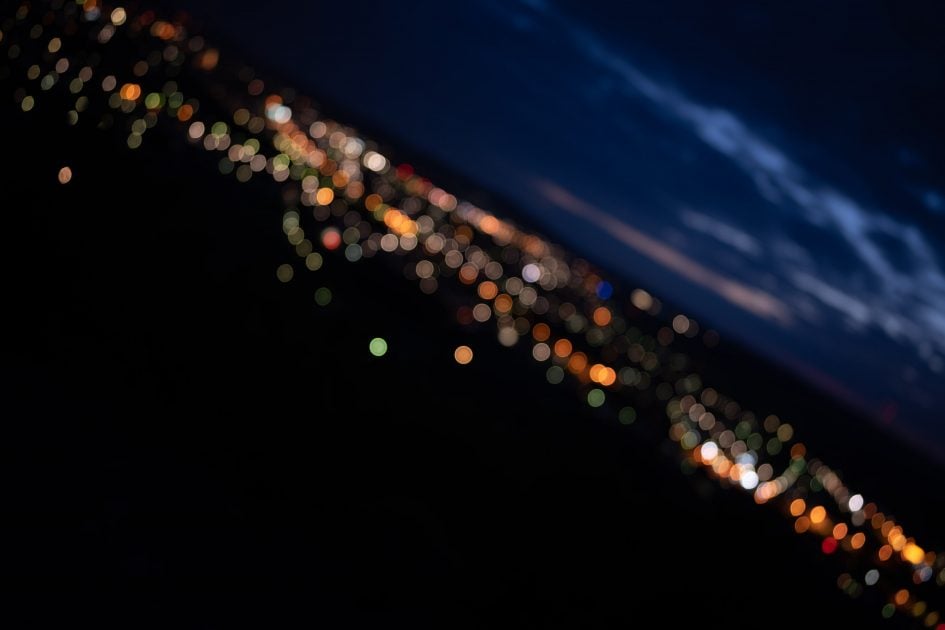
Above: Sigma 28mm f1.4 Art at f1.4; click image for 4k version, also available as large original at f1.4, f1.6, f1.8, f2.0, f2.8, f4.0, f5.6, f8.0

Above: Sigma 28mm f1.4 Art at f1.4; 44% crops from center, APS-C-corner, FF-corner

Above: Zeiss Otus 28mm f1.4 on a 36MP D810 at f1.4; 50% crops from center, APS-C-corner, FF-corner; click image for 4k version, also available as large original at f1.4, f2.0, f2.8, f4.0, f5.6, f8.0

Above: Nikon 28mm f1.4E on a 36MP D810 at f1.4; 50% crops from center, APS-C-corner, FF-corner; click image for 4k version, also available as large original at f1.4, f2.0, f2.8, f4.0, f5.6, f8.0
The three lenses in this comparison don’t look much different: All clearly show outlining in the center, some mild structure within the circle, and mild compression already at the APS-C-corner. Differences show in the cut-off from the mirror-box which is absent from the Sigma as it was shot on a mirrorless camera. And the Zeiss Otus shows less outlining outside the center.
Let’s see how this analysis of out-of-focus point-light sources translates into Bokeh-performance shooting a book-shelf.
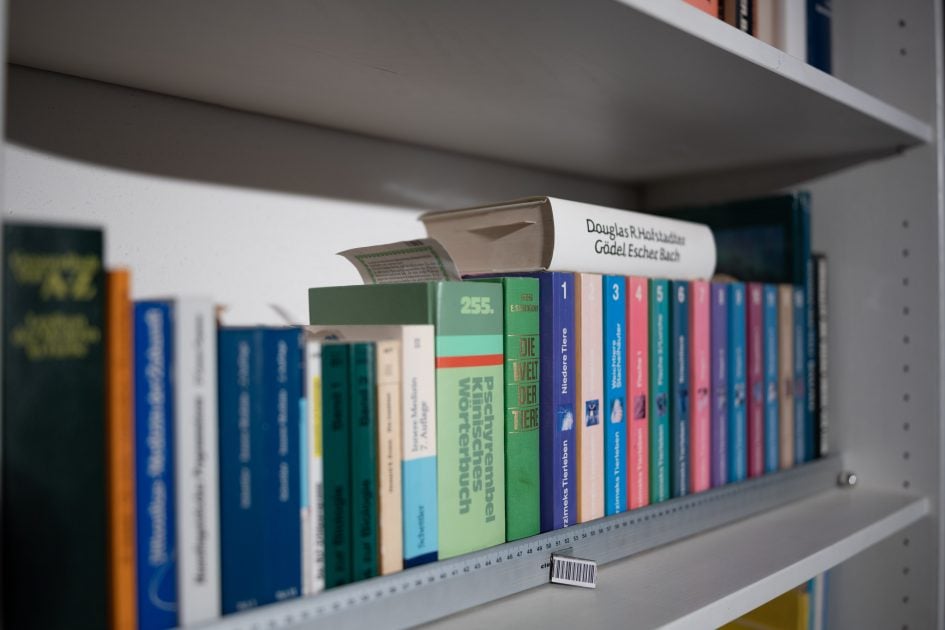
Above: Sigma 28mm f1.4 Art at f1.4; click image for 4k version, also available as large original at f1.4, f2.0, f2.8, f4.0, f5.6, f8.0

Above: Sigma 28mm f1.4 Art at f1.4; 44% crops from foreground, middle-ground, background

Above: Zeiss Otus 28mm f1.4 on a 36MP D810 at f1.4; 50% crops from foreground, middle-ground, background; click image for 4k version, also available as large original at f1.4, f1.8, f2.0, f2.8, f4.0, f5.6, f8.0

Above: Nikon 28mm f1.4E on a 36MP D810 at f1.4; 50% crops from foreground, middle-ground, background; click image for 4k version, also available as large original at f1.4, f1.8, f2.0, f2.8, f4.0, f5.6, f8.0
From the comparison above it is clear that the Sigma 28mm f1.4 Art has the best Bokeh of the bunch: The transition zone is soft and without coloration and the background is smooth and creamy. Even the less important foreground is not bad. This is a very good result for a lens of such short focal length.
Close-up performance
The Sigma 28mm f1.4 Art goes down to 1:4.5 magnification which is a little better than from the Nikon and Zeiss Otus. Performance of the Sigma Art in close-up shooting is OK once you stop down f5.6. The following image was shot at 1:4.8 magnification where the area of sharp focus is just 114 x 171mm. The crops shown below are (from left to right) from the center, 10mm, and 20mm off the center of the sensor respectively:

Above: Sigma 28mm f1.4 Art at f1.4, 1:4.8 magnification; 100% crops

Above: Sigma 28mm f1.4 Art at f2.8, 1:4.8 magnification; 100% crops

Above: Sigma 28mm f1.4 Art at f5.6, 1:4.8 magnification; 100% crops
Flare, ghosting, and sun-stars
Catching a strong light-source shining directly into the lens is always a risky business: it could produce strange colorful ghost-images or reduce contrast considerably through flare and glare. The appearance of flare and ghosting depends on factors like the aperture and the angle of the light hitting the lens. So to judge the proclivity of the Sigma 28mm f1.4 Art for these artifacts I went through a series of well calculated shots against a strong light source to provoke glare and ghosting.
The Sigma 28mm f1.4 Art is not very prone to flare and ghosting artifacts. The following image at f11 is one of the most obvious examples:
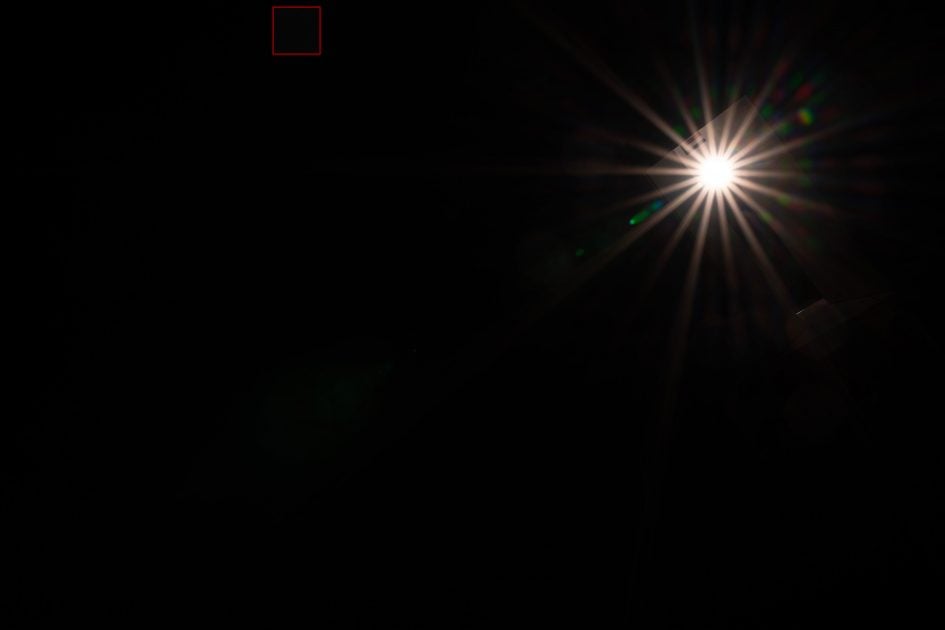
Above: Flare and ghosting. Strong light hitting the Sigma 28mm f1.4 Art at f11; click image for 4k version
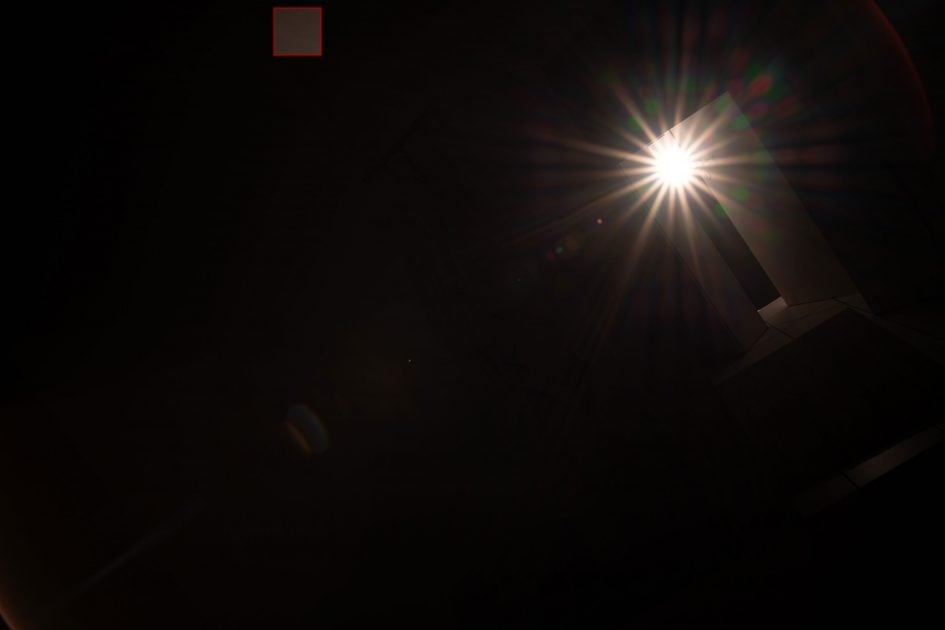
Above: Flare and ghosting. Strong light hitting the Zeiss Otus 28mm f1.4 at f11; click image for 4k version
The little square inset in the upper left of the image shows the respective area with an exposure compensation of +3 EV to make it easier to see which levels of black the lens renders at that point. It clearly shows that the Sigma 28mm f1.4 Art renders a very deep black against contra light – better than the Zeiss Otus. When the light-source is at or near the middle the veiling glare becomes a bit stronger.
All-in-all the Sigma Art let’s you shoot confidently under adverse contra-light situations. Sunstars are already well defined at f5.6 but naturally become better when stopped down further as the example below shows:

Above: Sunstars from the Sigma 28mm f1.4 Art at f5.6 (left) and f8.0 (right), 100% crops
Next check out my sample images!
Check prices on the Sigma 28mm f1.4 ART at Amazon, B&H, Adorama, or at WEX. Alternatively get yourself a copy of my In Camera book or treat me to a coffee! Thanks!




